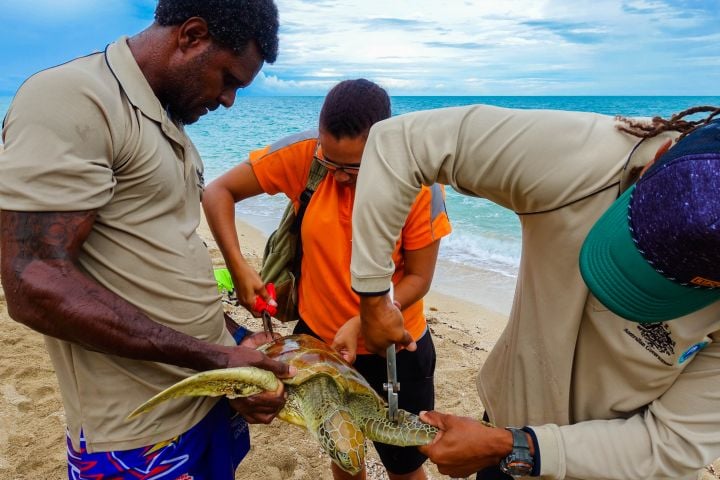
The Torres Strait turtle population, which is several hundred thousand strong, faces looming threats that can only be addressed through close cooperation between governments, researchers and local communities.
Torres Strait Regional Authority (TSRA) rangers are working with traditional owners and external partners to help ensure that marine turtles continue to be present and abundant in the Torres Strait for future generations.
“The TSRA’s marine turtle monitoring project is an integral part of the community based dugong and turtle management plans, as it aims to collaborate with Traditional Owners in identifying threats to marine turtles and manage these threats where appropriate and possible,” TSRA Chairperson, Mr Napau Pedro Stephen AM said.
Several species of marine turtles nest across the islands of the Torres Strait. There are large numbers of green turtle nesting beaches located within the Kemer Kemer Meriam Nation (eastern islands).
“The Torres Strait is an important foraging ground for green turtles, with large and healthy seagrass meadows providing them with abundant food,” explains Mr Stephen.
Additionally, what is considered Australia’s largest number of remaining hawksbill turtle nesting beaches are within the Kulkalgal Nation (central islands).
The continued observation of these turtles is made all the more important because of the new threats they face for survival.
Climate change is negatively impacting marine turtles. The increasing temperature is resulting in mainly female turtles being born, reducing the number of males in the population. Increases in sea level and the occurrence and severity of storms are deteriorating foraging grounds and nesting beaches.
Of absolute importance to the future of the Torres Strait’s green turtle population are the outcomes recorded on Raine Island, the world’s largest green turtle rookery and the main source of green turtle recruitment for the Torres Strait.
For at least 20 years, the number of hatchlings produced has been very low. Green turtle eggs are not surviving to hatch as a result of flooding from tidal waters and other factors, and a significant drop in the Torres Strait green turtle population is expected in the coming years. Recent adaptive management initiatives, such as the sand redistribution, have been implemented as part of the Raine Island Recovery Project with positive outcomes that have increased green turtle hatchling success at the rookery.
The long distances marine turtles travel also impacts their safety.
Monitoring by Rangers and their Islander communities have recorded turtles travelling as far as Heron Island in the south, New Caledonia and the Solomon Islands in the east, Papua New Guinea and Indonesia in the north, and to Western Australia in the west.
Outside the Torres Strait, threats such as coastal development, marine pollution, illegal fishing and trade and feral animal predation are all severely impacting marine turtle populations.
“This requires monitoring to be completed within the Torres Strait and in cooperative partnerships with those responsible for marine turtle management in the regions elsewhere that the Torres Strait’s marine turtles migrate and inhabit,” says Mr Stephen.
New priorities for the turtle monitoring program have been identified at a series of important meetings in May. The Raine Island Turtle Nesting Summit (16-17 May) brought together some of the world’s leading experts in marine turtles to discuss the situation on the Island, while TSRA Rangers and Land and Sea Management Unit (LSMU) staff and Traditional Owners met with government and academic experts at Brisbane and Townsville (18-19 May) to talk about the turtle stock and how to fill knowledge gaps in the program.
The role of the TSRA Rangers has evolved over the past 10 years. First, they undertook a capacity building role by working alongside researchers from James Cook University in a project that completed in 2014, and then the TSRA took a significant step forward by obtaining its own research and ethics approvals. By leading the monitoring and research Rangers will be at the forefront to identify and address marine turtle threats in the Torres Strait in collaboration with Traditional Owners, stakeholders and experts.
Mr Stephen said this is a fantastic step forward for Torres Strait Islanders.
“TSRA Rangers are continuously undertaking new challenges and increasing their skills and knowledge in order to take on additional roles and responsibilities within the community,” he says.
“The rangers’ focus is on looking after the Torres Strait’s natural environment while continuing its cultural traditions, and marine turtles are an important part of both the natural and cultural features of the Torres Strait.”
For more information please contact TSRA’s Project Manager for Sea, Tristan Simpson, on (07) 4069 0700.
ENDS

